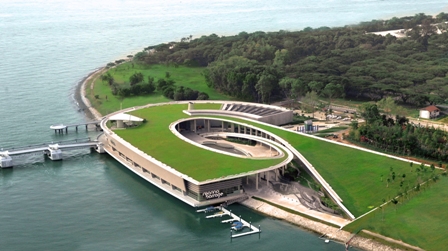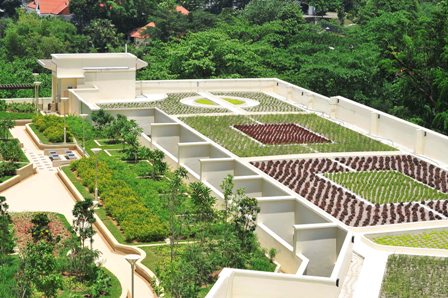 Whether a heavier ‘intensive’ roof which is irrigated and with grass, shrubs or plants, or the lighter ‘extensive’ variety with thinner covering and lower maintenance, the fundamentals are the same. Deborah Singerman reports.
Whether a heavier ‘intensive’ roof which is irrigated and with grass, shrubs or plants, or the lighter ‘extensive’ variety with thinner covering and lower maintenance, the fundamentals are the same. Deborah Singerman reports.
Green the roofs are a build- up of layers of products and material and installation know-how. The hardware — the ‘black arts’ — comprises structural support, then the waterproofing mem brane, filter fabric protection and the drainage system.
This is followed by the software — the ‘green arts’ — the substrate growing media, which is more than 300 mm for intensive and less than 300 mm for extensive, according to Elmich, which designs and manufacturers landscape engineering products). And then the plants themselves.
“You have to understand the physical properties of the media on top before you can fully select the media under it,” says Alistair Scott-Young, director of Junglefy, a company which designs, installs and maintains green roofs and walls.
While the basic principles and build- up is not complicated, there is no room for error, says landscape designer and horticulturalist Sidonie Carpenter, also president of Green Roofs Australia, the collective voice for Australia’s young but growing industry.
“In Australia we have very different building conditions and different species,” Carpenter says.
First, you have to work out why the client wants to install a green roof, says Jeff Sorrill at the research and demon stration Green Roof Centre in Sheffield in the north of England. He says “it all depends on what they want to achieve.”
The benefits of green roofs include reducing pollution (plants can trap par ticulates), stormwater retention, alleviat ing floods, reducing energy use, provid ing insulation, aesthetics, biodiversity (depending on media depth) and reducing the urban heat island effect.
Painting the roof a light colour to reflect heat and keep the building cooler is not enough, especially as it deflects heat back into the city, says Groof Consultants director, Ben Nicholson, also vice-president of Green Roofs Australia.

In contrast, green roofs absorb heat from the sun and lead to “evaporative cooling as plants transpire moisture into the atmosphere”, Nicholson wrote in his Churchill Fellowship paper after studying green roofs overseas.
Scale is important too. An influen tial Toronto study found that for a city’s temperature to drop by two degrees you would need around 10 per cent green roof coverage.
Promoting corporate social respon sibility is another benefit, though Carpenter warns that while green commercial projects in Australia are growing rapidly, there is a danger of using green roofs (and walls) as a marketing tool and of “people wanting to be seen to be green”.
Both she and Nicholson agree on the importance of integrating the sup ply chain and co-ordinating profes sionals and trades on projects, from architects, engineers and waterproof ing contractors to green roof installers, horticulturalists, planting labour and maintenance. These are also some of the areas where a lot more research — and work — is needed in Australia before reaching this ideal.
With water for green roofs, a grey water system (carefully monitored to avoid toxic cleaning products, for instance) could become part of the whole, filtering and pumping water back on to the roof. “As soon as you have water in the system you can sig nificantly reduce substrate depth because you don’t need to get the substrate to act as a water holding ele ment,” Nicholson says. “Hence you can start to increase the plant species able to live up there.”
Another barrier is weight. “Most of our roofs are engineered to 25 kg per sqm and even with a simple light weight green roof you are looking at 100 kg per sqm fully saturated,” Nicholson says.
Building code stipulations, engi neering solutions and cost will need to be considered, especially for identi fying what building stock can be retrofitted. Currently there is no Australian standard for green roofs, an absence especially noted for sub strates and plants.
Australian products include Fytogreen’s Hydrocell RG30 light weight water retentive substrate, but it uses a different soil structure from the normal, Carpenter says. More typical is Elmich’s VersiCell, a light weight, high-strength polypropylene modular drainage cell, or VersiDrain 25P, an interlocking plastic water retention and drainage tray. Atlantis has also come up with Go-Wall verti cal garden system modules to be fixed to structural walls.
Zinco, a long-standing, holistic green roof system, is negotiating with an Australian company for distribu tion here. The German company is backed by years of project experi ence, technical engineering expertise and simulation methods to test parameters such as climate, budget, media depth and water availability.
Junglefy worked with Zinco’s filter fabric and drainage storage layers (only part of the full system) on the Venny children’s community centre in Kensington, Melbourne. This was an extensive roof collaboration between the City of Melbourne and the University of Melbourne’s School of Land and the Environment.
Plant selection at different depths and data collection on water, weather, substrate moisture and so on will be ongoing. Burnley (including Nicholas Williams), is also looking at rooftop plants in drought which so far sug gests only succulents can survive long periods of water stress.
Melbourne University and Monash University will also be moni toring stormwater discharges, among other things, at a civic centre roof garden and Bent Architecture’s green roof at 131 Queen Street. The proj ect won a design competition run by the Committee for Melbourne’s Future Focus Group and has a grassy hillock and circular path. It is still under construction.
Another lesson, one of several from the Venny project, is that without good co-ordination, contracts may overrun and necessary planting sea sons be missed. Scott-Young speaks for many when he says “Trades need to understand the responsibilities they have to each other.”
Research at the Institute for Sustainable Futures (ISF) is currently looking into the role green roofs and walls may play in sustainable cities of the future. It will cover green roof’s potential to help maintain urban amenity, intimacy and natural sur roundings, reviewing international and local policy and practice.
An ISF intern from the University of Bayreuth and studying a Masters in Global Change Ecology is also work ing on the project. As part of its out reach, the ISF has also advised Frasers Property on the $2 billion Central Park development at Sydney’s former Carlton United Brewery site, where vertical wall expert Patrick Blanc will work with French architect Jean Nouvel to add vegetal wall pan els that may reach up to 150m in two residential blocks.
It looks like urban greenery is indeed on the up.

